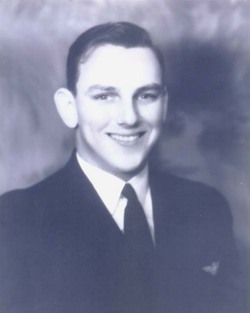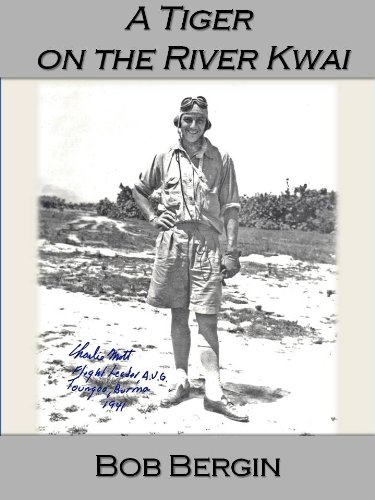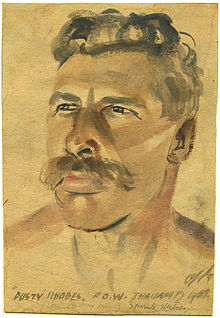In addition to the Merchant Mariners, who ended up at the Hintok area camps and the members of the 26th FA, there were a few other unique additions to the POW list.
A certain Harry Gray was a medic with the 1314th Med Grp. They were being evacuated from the Philippines in Jan 1942 aboard the USAT LIBERTY which was torpedoed by a Japanese submarine off the coast of Bali. Among the crew and passengers, there were no casualties. Although the story is not entirely clear, it appears as if he was rescued by the Bloemfontein. He was assimilated into the 131 Med detachment and transported to the TBR as part of the main body of POWs. He died of dysentery and Beri-beri in SEP 1943 at the 80 KILO camp.

Charles Mott
APR 2023 Update: Unique Story #3
When your journey is a unique one, there is no one to corroborate nor expand it. Therein we know only what the man himself would relate post-war to describe his TBR story.
Hence is the journey of Charles Mott. Although he himself would not consider it so, Mott was technically a civilian. He had resigned as a US Navy pilot in order to join the American Volunteer Group – known as the FLYING TIGERS. He is thought to have been the first US POW taken by the Japanese in Thailand when in early Jan 1942 he was shot down near Mae Sot in northern Thailand.
He suffered a compound fracture to his right arm when his parachute was caught up in a tree and he had to cut himself lose. He was placed on a train and sent to a hospital in Bangkok. After two months, his arm had healed and he was held at 2-3 different locations until AUG 42. He was placed on another train and delivered to the NongPlaDuk TBR POW camp. He claims to have ingratiated himself to a SGT Nomura by repairing the engine of a recently commandeered Ford car. They became pals!
In Dec 42, Nomura arranged for him to be placed in charge of 62 US trucks arriving from Singapore. His job for the next two and half years was to keep those tucks running to deliver supplies to Kanchanaburi from which they would be ferried up river to the various TBR camps.
He came to oversee 150 men who worked on and drove those trucks. They were nicknamed “Mott Motors”. His story was recorded as an interview and later published. At some points he seems to relate incidents that were common to the POWs on the TBR but may not actually have happened directly to him. For example, he speaks to cholera wiping out camps. But this occurred hundreds of kilometers from where he would have been. He indicates that at some point he was moved from the start point of the TBR at NongPlaDuk to the IJA HQ at Kanchanaburi. Although he does not name the place it seems from his description that immediately post-war he spent some time at the airfield at LatYa that the OSS had been using to bring in supplies. He also claims to have been evacuated to Calcutta from the airfield in Petchburi, but he relates it as Ratchburi.
It is perhaps worth of note that he is the only Allied POW associated with the TBR who had been taken captive while engaging in active combat. IOW, he never ‘surrendered’!
====================
Charles Mott was technically a civilian. He was a volunteer member of the FLYING TIGERS squadron. He reportedly had been shot down over Tak Province (near the Burmese border) on 8 JAN 1942 and was injured when he bailed out. After hospitalization in Bangkok and a short time in the civilian interment camp near Sanam Leung, he was sent to the NongPlaDuk POW camp where he joined forces with the RASC 62nd Truck and Motor Pool sending supplies along the TBR.
==========
In the middle of the day (8 Jan 1942), another flight of P-40 fighters from the 2nd AVG squadron took off to attack Mae Sot Airport, Tak province; three aircraft led by Charles Mott as the group leader included Robert Moss and Percy Bartelt with another P-40 operated by Gilpin Bright as an escort. At the time, Mae Sot Airport, Tak Province, was home to a squadron of Japanese Army fighters.
As a result of the attack, it appeared that four of Japan’s Ki-27 fighters were destroyed, three were damaged and at least one transport plane was also damaged, while Charles Mott’s P-40 was shot down as it diverted in an attack on a Ki-272 fighter jet. He parachuted at about 200 to 300 feet, was seriously injured, becoming the first Allied pilot to be held as a POW in Thailand. After being treated for his injuries, a week later he was allowed to broadcast on Bangkok radio that he was injured.
Mott was eventually sent to the NongPlaDuk POW camp in September 1942 with captives arrested in Singapore and Malayan.
It is thought that Mott may have been the FIRST US AAF POW in Thailand.


Little is documented about his POW experience beyond the fact that he was present. He had been a US NAVY pilot prior to the war (1937) and apparently resigned to join the Volunteer Squadron. He was said to be an avid chess player. He retired from the US NAVY as a CAPTAIN and is buried at Arlington Nat’l Cem.
Charlie resigned from the Navy in June, 1941 to volunteer for the AVG. He was placed in charge of the largest group of AVG (125) which sailed aboard the Dutch ship Jaegersfontaine from San Francisco for Rangoon on July 10, 1941. Upon arrival at Kyedaw Airfield, Toungoo, Burma he as assigned duties as Acting Group Adjutant and in this capacity assisted in the organization and assignment of personnel of the Group. He was designated a Flight Leader and operations officer of the 2nd Squadron. Charlie was relieved of Adjutant duties in mid-September. When the optical gunsights on their planes did not function, he took on the task of adapting and redesigning them resulting in a gunsight superior to the old “ring and ball” sights.
After the 2nd Squadron was deployed to Rangoon in late December, ’41, he flew experimental but ineffective missions against night attacks because close radar control was not available.
The AVG then seized the initiative by attacking Japanese airfields in Thailand. While leading an attack on the airfield at Mesoht [sic; Mae Sot] Thailand, he was shot down by ground fire and captured, severely wounded. He was the first allied pilot to be captured in Asia. The Japanese let him recuperate from his wounds and tropical fevers and in July, 1942 put him in with British troops captured at Singapore [at Nong Pladuk camp]. For three years he experienced the conditions in POW camps along the River Kwai railway and was repatriated at the end of the war.
Upon returning to the States, he was recommissioned into the regular Navy and completed a Naval Aviator career of Lt. through Captain, specializing in ordnance and guided missiles. He retired from the Navy in 1963.
His Navy career included command of a four-engine squadron and operations officer of an attack carrier. He was the planning officer in the 7th Fleet, responsible for the joint China (Taiwan) resupply Quemoy during the 1958 incident and was honored by the Chinese with the Cloud and Banner Medal. In his last job he was responsible for the production of all U.S. Navy tactical guided missiles, torpedoes, mines, rockets and miscellaneous ammunition and expendable ordnance including electronic gear.
https://flyingtigersavg.com/mott-charles-d
PVT Bruce “Dusty” Rhodes
This man’s story is a prime example of how errors creep into history and then get perpetuated.

This drawing of PVT Rhodes is often published with the caption as US POW. He was never actually a POW! He was the third and last TXNG member to be killed prior to them being taken as POWs. Two men had been KIA when the plane they were in was shot down during the first air attack on Singosari in early FEB.
The 2/131 had completed their mission to provide artillery support to the troops of Black Force and had withdrawn to a tea plantation in central Java to await resupply and new orders. Rhodes was killed by an accidental GSW on 7 MAR — the day before the Dutch authorities capitulated. The exact circumstances of that shooting are disputed but he was never actually a POW.
Lt(jg) Francis Weiler
When HOUSTON went down, a badly wounded Francis Weiler made it to shore. He was admitted to the hospital in Pandeglang, Java, on 15 March. Knowing that he did not have long to live, he gave his Naval Academy ring to a Dutch nurse in the hope that she could contact a U.S. naval officer and give it to him. She gave it to a Dutch doctor, and he, either willingly, or otherwise, gave it to a Japanese officer. Sadly, Lieutenant Weiler died of his wounds on 26 March 1942. His gravesite is unknown. He was the first US POW on Java to die.

In early November 1942, Gordon Gayle (USNA class of ’39), then a Marine captain, was involved in a firefight on Guadalcanal. Four Marine stretcher-bearers paused nearby and one of the Marines, knowing that Captain Gayle was an Academy graduate, handed him a ring that had been taken off the hand of a dead Japanese soldier up on the lines. Captain Gayle promptly put the ring in his pocket and did not look at it until there was a break in the action. When he did examine it, he was surprised to see that it belonged to a classmate. He remembered Francis Weiler as being chairman of the class ring committee.
In the eight months since HOUSTON sank, Lieutenant Weiler’s ring traveled more than 3,000 miles from Pandeglang, Java, to Guadalcanal. Its journey was not yet over.
Captain Gayle intended to return the ring to Lieutenant Weiler’s family, but felt that his chances of survival were marginal, so he decided to send the ring through official channels. He gave the ring to a fellow officer in his command post. This officer, Captain Swisher, from artillery, was about to return to his unit back in Henderson Field. Gayle asked Swisher to give the ring to the division quartermaster, the usual staff agency to return such items to the United States. Captain Swisher never made it back to his unit at Henderson Field. The 164th U.S. Army Infantry Regiment was nearby and desperately needed forward observers, so Swisher’s orders were changed. Tragically, he took a direct hit from a mortar and died an hour later.
It is believed that upon learning of his change of orders, Captain Swisher gave the ring to a Private Charles Stimmel, a radio specialist HQ CO, of the 164th. Again tragedy struck. Private Stimmel was mortally wounded by shell fragments on 23 November 1942 and died within the hour. His best friend was with him when he was hit and Stimmel asked the friend to get his personal effects back to his family in North Dakota. Among those personal effects was Lieutenant Weiler’s class ring.
Private Stimmel’s father wrote to Dr. George Weiler, Francis Weiler’s father, on 1 March 1943, a year to the day that HOUSTON went down, explaining how he came into possession of Fran’s ring. The ring was then personally returned to George and Florence Weiler at their home in Germantown, Pennsylvania, by a Marine courier.
Fran’s brother, Rear Admiral James B. Weiler ’31, USN (Ret.), donated the ring to the Naval Academy Alumni Association in 1961. It is currently on display in the ring collection at Alumni House.

2LT Roy Stensland
Roy Stensland was a Nat’l Guard Artilleyman deployed to Australia as part of the South Dakota NG’s 147 FA Rgt in early 1942. Soon thereafter he was sent on a special mission to Java to try to procure ships to rescue troops from the Philippines. No such ships were available. 2LT Stensland joined up with the 2/131 at Malang and participated in the defense of Java acting as a forward observer. Some of the POWs who recall him say he came from the Philippines on a mission to procure those ships but his military records suggest otherwise.
As a POW, we are only aware that he was part of the Fitzsimmons Grp #3 and that he was liberated from the Kanchanaburi Camp in AUG 1945.
Stensland-profileCOL Albert Searle
COL Albert Searle was the highest ranking officer taken as a POW on Java. He was the Commander of the 26th Field Artillery Brigade operating under the 61st FA Brigade. When that command evacuated, Searle remained on Java with a few of his men. They eventually affiliated themselves with the 2/131. Searle is said to have attempted to resist capture and assemble some men to continue the fight against the IJA invaders but within a few weeks, the IJA had such total control of the island that all were captured; likely turned in by locals.
After a brief stay at the Bicycle camp with the other US POWs, he was transferred to the senior officers camp in Mukden Manchuria.


=====================
Per the report of a HOUSTON survivor[1], there was a USMC Gunny Sgt who made it to shore. He was last seen heading off into the jungle carrying a .45 pistol.
His USS HOUSTON crew list citation lists him KIA as if he had not made it ashore. Technically, he was not a POW, yet he may have been the first to die on Java. Makes one wonder if others survived the night in the water only to be killed by the IJA or perhaps even natives [2] that next morning. Whatever the actual circumstances of his death, he may have been the first HOUSTON survivor to die after reaching shore.
| Standish | Walter | G/SGT | USMC | 3/1/42 | USS Houston | Enemy Action |
[1] Douglas, Griff L. (OH 0425) USNV SN 3564416
[2] see Section 27 concerning the ‘reception’ some of the PERTH crew received
There is no reason to doubt the account that Griff Douglas says he saw GnySgt Standish on shore that morning, but Howard Charles remembers it differently. As recounted in James HORNFISCHER’s seminal tome on the USS HOUSTON, Charles says he left Standish manning a 50-cal machine gun after telling Charles that he couldn’t swim. There is no reason that both cannot be true. Standish was last seen on the ship alive, so he could have later been seen ashore alive as well.
Standish-profileThe punishment of Ringer Edwards:
